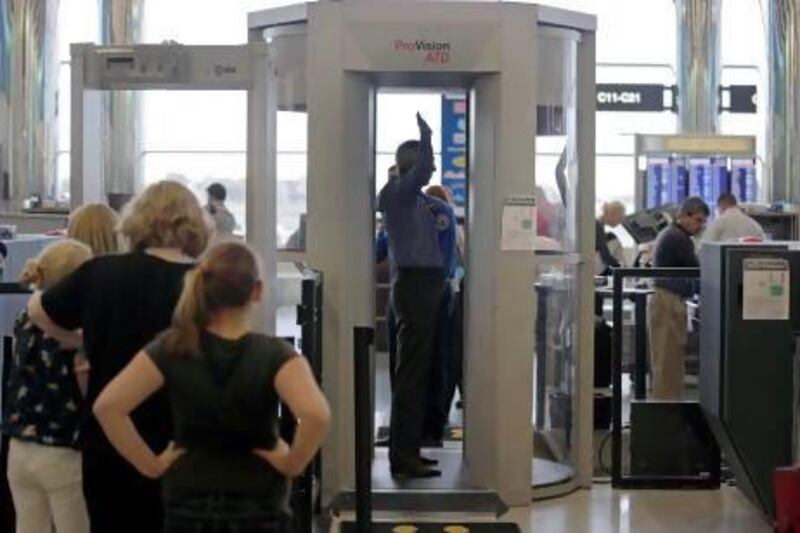The intrusion and inconvenience of airport security checks will be a thing of the past by the end of the decade, according to the airline industry's umbrella body.
"Our vision is that by 2020 travellers will move through the checkpoint without standing in line, removing outerwear or unpacking laptops and liquids," Tony Tyler, the chief executive of the International Air Transport Association (Iata) told a conference of airline executives in Vienna this week.
He was referring to progress by an ongoing industry project called Checkpoint of the Future, which could soon be replacing security checkpoints around the world.
According to Mr Tyler, security checks are not just a hassle for individual passengers, but a bottleneck threatening the efficient and economic operation of the global airline network.
"Passenger numbers have nearly doubled since 2001. And they will likely double again by 2030," said Mr Tyler. "The vast majority of these passengers pose no threat. But we treat them all alike. This one-size-fits-all prescriptive model for security is not sustainable. If we don't evolve it, the system will grind to a halt under its own weight.
"Before 9/11 the average checkpoint processed 350 passengers per hour. Today it is below 150. That's why we need a risk-based model. This concept underlies the Checkpoint of the Future project. Risk-based security is about making better use of the information that is available to assess the likelihood that people, objects or situations can pose threats."
Dubai and Abu Dhabi International Airports have already introduced streamlining measures.
Both have adopted the eGates system for example, which allows UAE citizens or expatriates holding UAE residence visas, with an eGate card, to pass through passport control without having to wait in a queue to have their passport stamped.
The process requires the passenger to swipe their card and touch a panel that identifies their fingerprints, confirming their identity and allowing them to enter or leave the country.
And when it is completed, Abu Dhabi's new Midfield terminal will be equipped with the latest passenger-handling technology, much of it currently being pioneered by the Iata project.
But while airports around the world are already implementing their own time-saving solutions, the Iata project is seeking to establish a uniform procedure that can be recognised by all security agencies involved in policing aviation.
Under Checkpoint of the Future, passengers will be directed to one of three 20-foot long corridors allowing them to undergo a "normal scan", an "enhanced scan", or to go through a "known traveller" lane. Which corridor passengers are directed to will depend on the level of pre-screening they have opted for, and sorting passengers by threat level.
This will be achieved by using passenger information that is already required by many governments for purposes of customs and immigration, and sharing across borders with the security agencies at their destination.
"Known travellers", for example, will be carrying a chip, in their passport or on a card, containing all relevant personal details they have consented to share with the authorities at their departure airport, and destination. Because they will be "known" to the security agencies they will require a simple identity check confirmed using a retinal scanner.
"Normal scan" passengers begin their security check, not by unpacking bags, taking off shoes, or being patted down, but by walking through their assigned corridor while sensors embedded in the walls scan their person, allowing them to pass "with dignity", according to Iata.
Full-body imaging will only be for the enhanced security lane. Some critics have said the new project has serious privacy issues, but Mr Tyler says he has detected no reluctance on the part of passengers.
"Sharing information about passengers is a sensitive subject, but our passenger survey shows that nearly three out of four air travellers would be willing to share personal information with governments to speed up security screening," Mr Tyler said.
The project also envisages moving many of the check-in steps away from the airport, allowing passengers to "do-it-yourself" in six key processes: check-in, bag check, travel document scanning, boarding, flight re-booking and baggage tracing.
"Iata's latest Global Passenger Survey reveals that 52 per cent of travellers are eager to print out their own bag tags at home and 77 per cent would prefer to use a self-boarding gate at an airport," said Mr Tyler. "Our 2020 vision is for a fast, seamless curb to airside experience that is predictable, repeatable, secure and globally consistent. By focusing resources where the need is greatest we will make the system more secure and reduce the hassle for our customers."
"We are now focused on implementation of the Checkpoint of the Future Roadmap. Important component trials with airport partners have already taken place at Geneva, London Heathrow and Amsterdam Schiphol.
"For 2013, we are planning 10 trials that will support rollout of the first end-to-end checkpoint in 2014."





